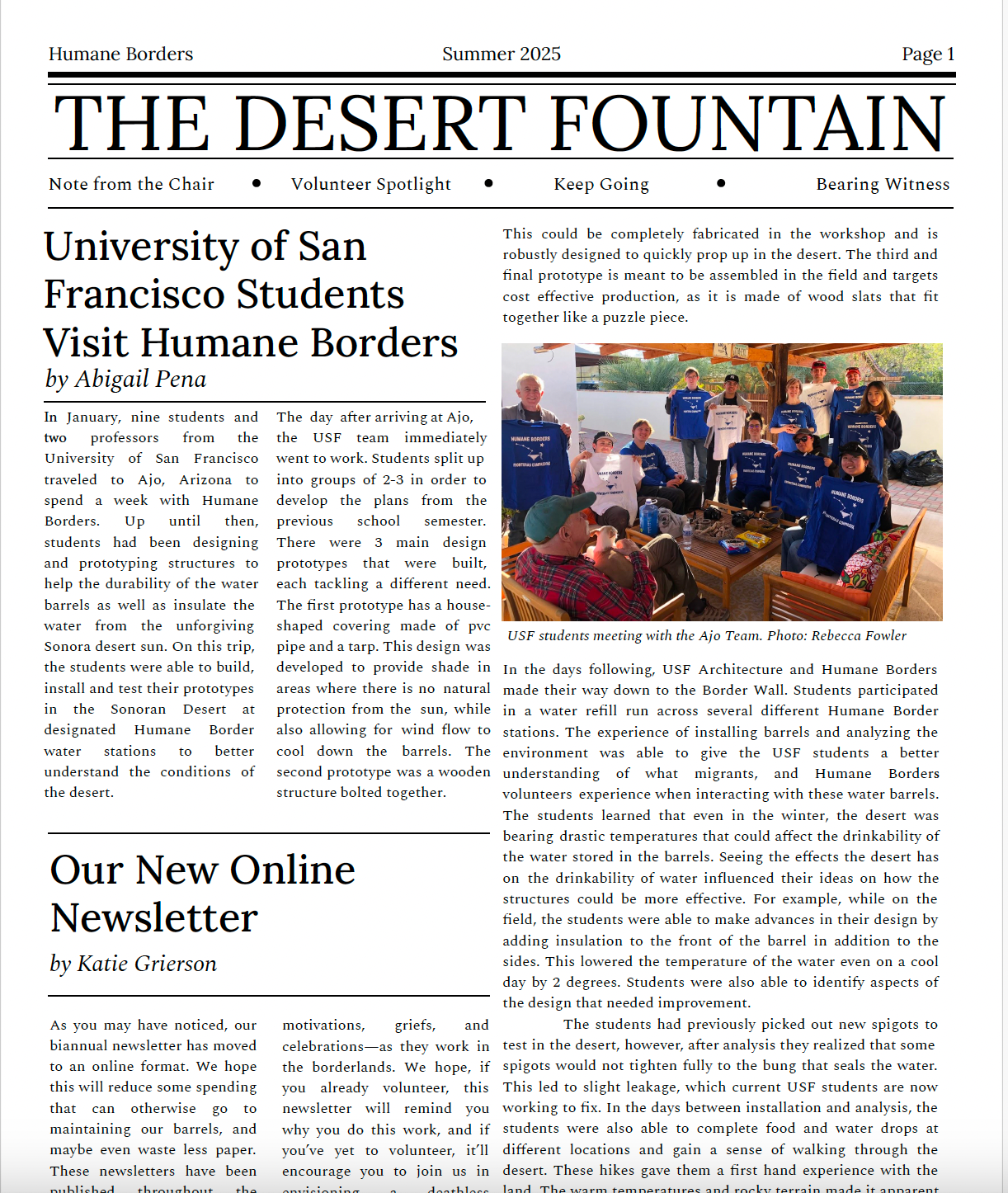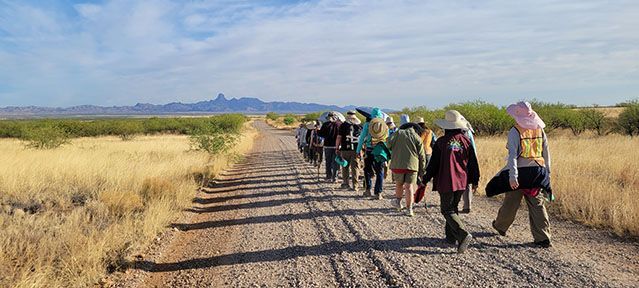Blue barrel diaries
a humane borders blog
University of San Francisco Students Visit Humane Borders
By Abigail Pena
In January, nine students and two professors from the University of San Francisco traveled to Ajo, Arizona spend a week with Humane Borders. Up until then, students had been designing and prototyping structures to help the durability of the water barrels as well as insulate the water from the unforgiving Sonoran Desert sun. On this trip, the students were able to build, install, and test their prototypes in the Sonoran Desert at designated Humane Border water stations to better understand the conditions of the desert.
The day after arriving at Ajo, the USF team immediately went to work.
Students split up into groups of 2-3 in order to develop the plans from the previous school semester. There were 3 main design prototypes that were built, each tackling a different need. The first prototype has a house-shaped covering made of PVC pipe and a tarp. This design was developed to provide shade in areas where there is no natural protection from the sun, while also allowing for wind flow to cool down the barrels. The second prototype was a wooden structure bolted together. This could be completely fabricated in the workshop and is robustly designed to quickly prop up in the desert. The third and final prototype is meant to be assembled in the field and targets cost-effective production, as it is made of wood slats that fit together like a puzzle piece.
In the days following, USF Architecture and Humane Borders made their way down to the Border Wall. Students participated in a water refill run across several different Humane Borders stations. The experience of installing barrels and analyzing the environment was able to give the USF students a better understanding of what migrants and Humane Border volunteers' experience when interacting with these water barrels. The students learned that even in the winter, the desert was bearing drastic temperatures that could affect the drinkability of the water stored in the barrels. Seeing the effects the desert has on the drinkability of water influenced their ideas on how the structures could be more effective. For example, while in the field, the students were able to make advances in their design by adding insulation to the front of the barrel in addition to the sides. This lowered the temperature of the water even on a cool day by 2 degrees. Students were also able to identify aspects of the design that needed improvement.
The students had previously picked out new spigots to test in the desert; however, after analysis, they realized that some spigots would not tighten fully to the bung that seals the water. This led to slight leakage, which current USF students are now working to fix. In the days between installation and analysis, the students were also able to complete food and water drops at different locations and gain a sense of walking through the desert. These hikes gave them a first hand experience with the land. The warm temperatures and rocky terrain made it apparent that the work Humane Borders does is imperative to saving lives. In addition to the climate, the desert was covered in a diverse range of cacti that can easily get caught on clothing and bodies. Some of the students even got painfully pricked while hiking. The physical challenge of crossing a desert without enough food and water became vivid imagery through this experience.
On one of the hikes, students passed by a cross that was placed by another organization that sends search and recovery parties into the desert. These crosses are placed where they find the remains of those who did not survive the desert. Personally witnessing such a sight showed the work Humane Borders does has meaningful ramifications. Above all else, human beings do not deserve to die in such conditions. Through water barrel stations, they are providing a lifeline for those making this difficult journey. The USF students and professors who went on this trip are excited to be joined by new students in an effort to further improve the water barrel structures. They hope that this becomes a recurring trip to the Sonoran Desert to continue their relationship with Humane Borders and others, as we work to make the world a better place for all.
My experience with Humane Borders was life-changing. As a student at USF, I had the amazing opportunity to design water barrel structures with the Humane Borders team for 8 days. The team flew into Ajo, Arizona, on the 12th of January in order to build and install the water barrels. Throughout the week, the team was able to do water and food drops in numerous Humane Borders locations.
The hikes through the desert and first hand experience with the environment opened my eyes to how important Humane Borders’ work truly is. Something as simple as providing water becomes life-saving work for migrants crossing through the Sonoran Desert. The volunteers we met on this trip have proven to have a genuine passion for saving and helping lives. In the months of reflection that I have had since this trip. My admiration for the determination and kindness of the Humane Borders team has only grown. In the coming years, may we continue to lead with courage and integrity, standing beside those who need us.



